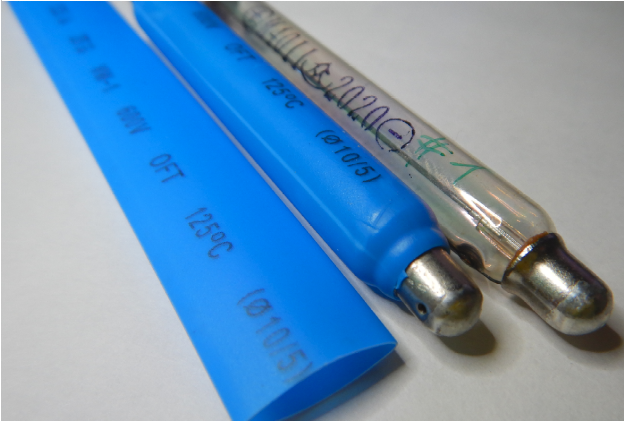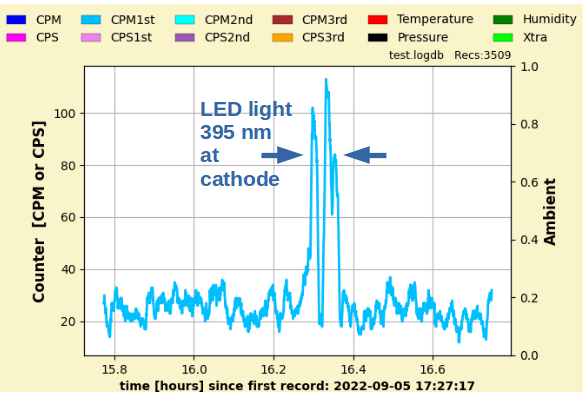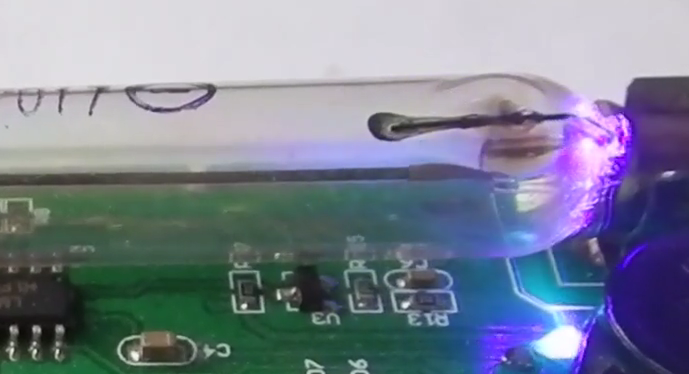| T O P I C R E V I E W |
| SelTec |
Posted - 08/10/2022 : 05:41:05
Hi everybody!
I wanted to get your opinion about the state of my GMC-320 Plus (V4 without WiFi module).
Last Saturday it started going haywire out of the blue, CPM count rising sharply up to 5100CPM and then dying down slowly over the next 20 minutes. I carried the thing around and even wandered into the cellar (no Radon gas there afaik), but it did not seem to affect the count. Gave me quite an unwanted adrenaline rush in the early hours.
Since none of the government measurement stations or any of the counters on gmcmap.com registered anything, I became suspicious about the state of the device. I got a 1G 1% resistor and checked the tube voltage - about 394V so seems to be ok.
I then took the device into the bright midday sunlight today, facing the grill with the tube upwards.
Result: From ~25CPM rising up to ~4200CPM. Yes it is a clear M4011 tube, but this reaction seems a bit over the top to me.
So from your experience, would you say the tube is knackered? I might go ahead and hunt down a SBM-20 tube. Maybe I expect too much from such a simple device.
Thanks for your help,
Tobias |
| 21 L A T E S T R E P L I E S (Newest First) |
| ullix |
Posted - 09/06/2022 : 00:58:26
Testing heat-shrinking tubing:

The blue stuff has just the right size - it barely allows to insert the tube (which is good). After shrinking I cut off the ends, but made sure that the initial stubs of the tube-end-caps were still covered. No light can pass there, and contacts can still be made.
However, the plastic itself is a bit translucent. After exposing to 395 nm LED light, the photo-sensitivity is still present, as a GeigerLog recordings tells:

I don't have any black tubing available, so can't tell whether that is less translucent.
Again, only the cathode end is light sensitive.
I wonder whether anyone can test the new tubes with the black wrapper for light sensitivity?
|
| SelTec |
Posted - 09/06/2022 : 00:56:42
Well as i said, i have put an SBM-20 in my Geiger counter now. So the dodgy M4011 is spare. I can take a few high-res fotos for you and then put it in a box for future experiments or donate it to somebody who has time and motivation to investigate this further.
-Tobias |
| ullix |
Posted - 09/05/2022 : 23:40:22
quote:
chewing gum if it is wet can be likened to a resistive conductor facing 400v and drop the tube voltage.
Nothing beats an experiment. So I enjoyed a gum and then measured resistance of the blob with a DVM. It went up from 500 kOhm initially to beyond measuring range after 3 hours of drying. However, this is not helping much, as we need >GigaOhm resistance, and the DVM's range isn't anywhere near this level.
Using chewing gum for this purpose is not a good idea; I take this proposal back.
|
| Damien68 |
Posted - 09/05/2022 : 00:59:44
quote:
Originally posted by ullix
@Damien: Very nice, a much younger article, only 65 years old as opposed to 70 years ;-)! Keep searching!
@ullix: More recent articles? ... On this forum I found contemporary discussions with some experimentations but I think you already know them. 
quote:
@SelTec, as you seem to have a particularly bad tube, you can try this wrapping approach. Perhaps use heat-shrink tubing, or wrap aluminum foil. Make sure that all gaps at the ends are fully closed; cover with some non-conductive potty, perhaps even chewing gum might do the job. I am curious for results.
be careful not to make a short circuit between the anode pad and the cathode pad of the tube with aluminum foil.
chewing gum if it is wet can be likened to a resistive conductor facing 400v and drop the tube voltage.
|
| ullix |
Posted - 09/05/2022 : 00:11:10
@Damien: Very nice, a much younger article, only 65 years old as opposed to 70 years ;-)! Keep searching!
Sounds to me like yet another mechanism is described which results in Photo-sensitivity of a Geiger tube. They state that "Relatively short wave radiation" is needed and had referred to UV light, while we were able to trigger the effect with less energetic, visible, blue light of 405 nm.
But it again underlines the notion that things happen in glass Geiger tubes, which do make them light sensitive.
The cathode poisoning, while not directly related to Geiger tube photo sensitivity, is also showing what strange effects can result inside of (glass) tubes.
We have the situation that these photo effects are known for decades, yet there are two Chinese manufacturers of glass tubes, the M-tubes, and the J-tubes (or is that one and the same manufacturer?), are (is) cranking out glass tubes by the thousands, ignoring the known science!
It would not have happened if they had used metal-case tubes. May the SBM20 live forever!
The good news in all this is that, at least as we see so far, counts will result only when light reaches the inside of the glass Geiger tube. So there is hope that a completely light tight wrapping prevents such photo counts.
@SelTec, as you seem to have a particularly bad tube, you can try this wrapping approach. Perhaps use heat-shrink tubing, or wrap aluminum foil. Make sure that all gaps at the ends are fully closed; cover with some non-conductive potty, perhaps even chewing gum might do the job. I am curious for results.
|
| SelTec |
Posted - 09/04/2022 : 12:55:37
Very interesting Damien. Unfortunately I am no doctor of chemistry.
Here is the link about cathode poisoning. Not exactly relevant here i think: https://www.sweetwater.com/insync/cathode-poisoning/
My naive amateur explanation is that over time some of the gas ions or some left over oxygen from insufficient evacuation of the tube, can deposit / latch onto the cathode and form some residue which increases sensitivity to light.
Kind of like electrolythic coating a copper coin in saltwater by connecting it to a battery and using some lead on the anode which gets deposited onto the coin.
Maybe something similar can happen very very slowly over time when you have some reactive gas left over in the tube.
Alas just speculating. I have no clue and was just super surprised that i got 4200cpm in sunlight with my M4011 tube. As bad as it can get i guess...
Did anybody see any visual differences between a light sensitive and a not light sensitive tube? E.g. where the nickel wire is welded into the glass and makes contact to the metallization film on the glass tube?
|
| Damien68 |
Posted - 09/04/2022 : 08:21:27
Hi SelTech,
you have found a good article.
following your article I found another one written 5 years later:
https://www.sciencedirect.com/science/article/abs/pii/0016003258903909
I just read the abstract, it seems also interesting. |
| SelTec |
Posted - 09/04/2022 : 07:05:51
I guess these Chinese glass tubes are churned out ultra cheap. So if you are lucky they work okayish. If something goes wrong during evacuation and gas filling in production, they are probably bad to begin with.
I also found the term "cathode poisoning". Something old radio tubes with glowing cathode suffered from over time. Probably not relevant here though.
I guess the knowledge how to build these things with good quality is dying out or already has died out.
So bridge the gap until semiconductor based detectors catch up and come down in price with soviet era NOS tubes.
|
| ullix |
Posted - 09/04/2022 : 04:41:50
quote:
One thing I noticed is that the anode is a bit loose on the M4011. It rattles like the filament in an old light bulb.
All my light sensitive tubes are tight, not rattling not even a little bit. So, this is disconcerting, but not the cause of light sensitivity.
Now with your article we can firmly conclude that it is an inherent property of glass Geiger tubes, known about for 70 years!
|
| ullix |
Posted - 09/04/2022 : 04:37:40
quote:
Regarding light sensitivity i found this article in german.
Wonderful! This article is from 1953, so we are only 70 years behind the state of Science :-((
I always find it a shame when research paid for by the tax payers is made available to those already having paid for it only by paying again! Alas ...
For convenience I am putting the summary as a Google translation - which I verified to be quite good - at the end.
The author is concluding the very same things that we have already discussed here in forum in the various topics on light sensitivity: It is a photoelectric effect (Einstein got his only Noble prize for the quantum explanation of it) acting on both the inner surface of the glass tube and on the gas volume.
They give a more detailed explanation, but they cannot offer a remedy.
But we can now conclude:
- Light sensitivity of Geiger tubes made from glass is an established fact
- Known for at least 7 decades
Why, exactly, are we still using glass tubes?
quote:
Schwarz, H. Die Lichtempfindlichkeit von selbstlöschenden Geiger-Zählern aus Glas mit Außenkathode. Z. Physik 134, 540–545 (1953). https://doi.org/10.1007/BF01330330
Summary
Some research is being conducted to find an explanation for the photosensitivity of external cathode self-extinguishing glass Geiger counters. The effect manifests itself in the occurrence of spurious counting pulses or double pulses in daylight. We could distinguish between a photoelectric effect at the inner glass surface (surface effect) and within the gas volume (volume effect). The volume effect seems to be connected with the attachment of electrons to oxygen molecules, which either remained in the tube or were created by decomposition of the alcohol vapor during operation of the counter tube. When oxygen enters a metastable state by light absorption, the electron attachment probability increases considerably. — The surface effect appears to decrease with the decrease in the work function of the glass upon adsorption of e.g. B. to be connected to hydrogen, which results from the decomposition of the alcohol vapor.
|
| SelTec |
Posted - 09/04/2022 : 02:21:56
Got the SBM-20 and replaced the M4011 tube.
One thing I noticed is that the anode is a bit loose on the M4011. It rattles like the filament in an old light bulb.
Regarding light sensitivity i found this article in german. Didn't spent the 40€ to buy it, but the excerpt might give a hint:
https://link.springer.com/article/10.1007/BF01330330
|
| ullix |
Posted - 08/17/2022 : 00:01:41
Oooh, you are way off - it is only 22 years old :-))
Click on the bottom-most, right-most link of this forum page (it is not even a secure SSL link) h**p://forum.snitz.com/ to see:

Last update is 2009. In Internet times it can indeed be considered as deceased.
So, strongly light sensitive. If you have any clue as to why this might be so, don't hesitate to post pics or else! Physical cause is still a mystery.
|
| SelTec |
Posted - 08/16/2022 : 05:13:35
Ok that was unfair! Just a 27yo forum software then...
Btw. yes the tube is super light sensitive on the cathode side. A bog standard led flashlight does the trick. |
| ullix |
Posted - 08/14/2022 : 22:02:50
quote:
The charme of the 80ies. ;) )
You missed it by more than a decade. It all began with "Windows95", which gives you a hint on the year. Remember "You've got mail!"?
|
| SelTec |
Posted - 08/13/2022 : 23:12:19
Thanks ullix!
Yes I meant swapping the anode resistor to 5M of course. Great so i just swap out the tube and hope for an improvement.
(This forum is completely unusable on the smartphone btw. I should switch it to a disposable email alias before it gets hacked. The charme of the 80ies. ;) )
|
| ullix |
Posted - 08/12/2022 : 02:50:29
"calibration":
No point in changing anything; your counter may - for the first time - be properly "calibrated". Read about my calibration-frustration in chapter "Appendix G – Calibration" of the GeigerLog manual :-((
|
| ullix |
Posted - 08/12/2022 : 02:39:56
"5G" ??? I guess this is a typo and you meant "5M"? GigaOhm resistors are needed only when you want to measure anode-voltage with a DVM.
I think the anode resistor is ok as it is. I have used an SBM20 with the built in resisitor, and all was ok.
Very likely a photo of the tube will not show anything. If you believe to see something, point it out.
What would be of interest is if you could scan the tube with a thin light beam, laser or LED, as I did in the youtube clip. I bet you will again see a response only at the very end of the cathode.
|
| SelTec |
Posted - 08/12/2022 : 00:00:07
Thanks ullix!
I decided to swap it with a SBM-20. 4000CPS just wandering outside and without taking the back cover off is a bit too much. I take a snapshot of the M4011 when i take it out.
Now i just need some basic "calibration" / conversion factors to put into the menu. Should I also change the anode resistor to 5G?! Hmmm...
-Tobias
|
| ullix |
Posted - 08/10/2022 : 23:43:51
Once you are burdened with a light-sensitive tube, any count number is possible.
I have about a dozen glass tubes (M4011, J305) and about half of them (50% !) are light sensitive. And it does not need UV light; as demonstrated here, visible light of e.g. 405 nm (dark blue) also works:
https://www.youtube.com/watch?v=l3Kw6xb5Nl0

In all cases I have seen so far the problem is the cathode end. It could be a tiny spot near the very end.
|
| SelTec |
Posted - 08/10/2022 : 07:52:44
Thanks Damien...
Yes there are several postings here about light sensitivity. But I was under the impression we are talking about idk. 25-50 CPM more than without light. I get a factor of 168 times more CPM, which seems a bit unusual to me. I could try adding one or two layers of black heat-shrink.
Does anybody else have an opinion if 4200CPM in sunlight is "normal" for a clear M4011?
Thanks,
Tobias |
| Damien68 |
Posted - 08/10/2022 : 07:19:00
your M4011 tube seems to be a UV sensitive tube. some are not UV sensitive others are even if they are new, this depends on how the tube was made, they are not all strictly identical.
you can also try placing an electrical sheath or other insulating material around the tube to block UV. |

